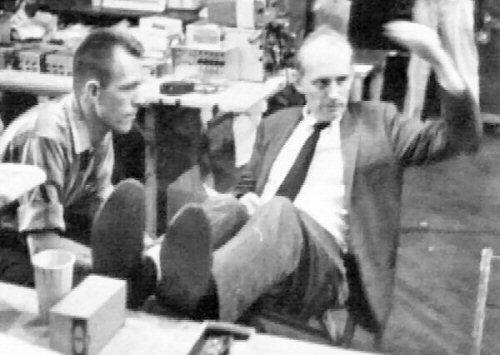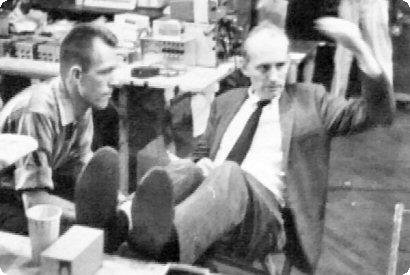Frances Dyson, And then it was now
Art and Technology
Artist
Collaboration between artists and engineers was one of the hallmarks of 9 Evenings, and of E.A.T. Comments from the artists involved reveal, however, that the various projects were beset by enormous and persistent technical problems; and fundamental communication problems around issues basic to both engineering and art meant that, at some level, neither the engineers nor the artists understood what either was trying to accomplish. Alex Hay summed up the situation as follows: “I kept saying this: we don’t really know what to ask but, mainly, we can’t ask for anything because we don’t know what to ask.” (1)
While Hay’s performance was fraught with problems, he was thankful for the advice of the engineers, who persuaded him to switch from a “mechanical focus to a sound focus.”
While many of the artists involved had mixed feelings about working with engineers, the most critical comments — of those openly expressed — came from Yvonne Rainer and Deborah Hay, who found the technology to be almost an impediment to the execution of their pieces. Hay was openly political in terms of the gender issues involved:
“The kind of materials and engineering equipment [involved were] very masculine. Engineers and the whole science and technology thing is a very masculine thing. [...] It was a revolutionary thing, it didn’t just evolve, it was pushed and shoved and brought together.” (2)
Interviewing Yvonne Rainer, Alfons Schilling commented: “I have the feeling that you didn’t make the piece because of the technology, but in spite of the technology.” And Rainer replied, “I have that feeling, too; probably the only really essential aspect of the technology that I used was the walkie-talkies, [which] in a way wasn’t essential.” (3)
Deborah Hay, on the other hand, found the experience of 9 Evenings so traumatic that she was unable to work afterwards.
Certainly there were the issues of continually failing technology, a lack of rehearsal time, having to work with engineers (who had a very different world-view) and operating on unknown terrain. But there was also, however, the problem of unrealistic expectations based on the pre-publicity and on preconceived notions of technology as something that made anything possible. Deborah Hay has said that the audience, and people generally, were judging the event as, in a sense, the debut of “Art and Technology,” and were approaching it with a certain amount of — to use her own expression — “greed.” They seemed to be saying, “OK, show me what you got!” It was as if the performances had already entered the circuit of consumption, were like a trade show or (as many people described them) a circus.
Engineer
Both artists and engineers put enormous amounts of unpaid time into the project, especially in the design and construction of the Theatre Environmental Modular Electronic (TEEM). Per Biorn, one of the main engineers involved, was impressed by the way artists were so forthcoming with their help:
"What impressed me was the number of artists who came in off the street and watched; and we handed then a pair of pliers and they would spend the day making cables. Yeah, even Cage was ‘drafted’." (4)
Engineers and technicians from Bell Laboratories also worked on a voluntary basis in their spare time — until it became clear that the equipment for 9 Evenings would not be ready in time for the performance. This led John Pierce to free the engineers from his division so that they could work full time on the project.
There was, then, a huge investment in time from both sides, creating performances that were not simply the result of happenstance but carefully crafted through gruelling hours of such mundane tasks as soldering and cable-making. Because of this investment, Biorn, like some of the artists, was disappointed with the lack of explanation provided for the work, which left the audience clueless as to what was part of the performance, and what was an accident or a mistake:
“Billy [Klüver] and Bob [Rauschenberg] had agreed that we would present the work but explain nothing. [...] I felt at the time that, if we had explained a little of it, the criticism would have been a little less, [and we would not have to hear things like] “disharmony at the Armory.” (5)
Many of the engineers also felt stymied by Klüver’s dictum — still current today in collaborations between artists and engineers — that “the engineer must never dictate the art form to the artist; let the artist ask the searching questions about the technology, and then the engineer should resolve the feasibility, trying never to discourage the artist’s demands.” (6) According to the engineer Robby Robinson, this was a source of tension; it “slowed down the process of securing a rapport with the artist. Even as late as two weeks before the show was to open, I heard too many engineers lamenting that they did not understand what the artist was trying to do or convey.” (7) With the engineers “running around frantically, searching for clip leads, soldering irons, test oscillators, oscilloscopes, etc.” the artists could often only stand by and watch. “But never did the engineers express doubt in front of the artists. The theme was always ‘things are going well’. How different this was from the real facts!” (8)
Robinson sums up the dilemma thus: “The engineer, by training and environment, deals in theory and precision laid down in the textbooks and demanded by the laboratory He evaluates most of his technical and social existence with a decimal point. He can readily hypothesize all situations that create balance and harmony and instinctively abhors distortions and unbalances unless they serve a direct purpose. How then, can he find a common ground to meet with the artist, who is basically a philosophic creature and readily impinges on the very characteristics an engineer must have by nature.” (9)
TEEM
If anything held together the performances of 9 Evenings, it was the engineer Billy Klüver, the artist Robert Rauschenberg, and an entirely new piece of technology modeled essentially on a telephone switchboard. The Theatre Environmental Modular Electronic, or TEEM, was reported at the time as being responsible for “the first electronic environmental system ever developed for theatre use; [it consisted of] 289 components — portable electronic amplifiers, equalizers, transmitters, receivers, distant control equipment, and proportional control equipment. It permits simultaneous remote control of multiple sounds, lights, and movements of objects.” (10)
The analogy to a telephone switchboard is not entirely simplistic because, on the one hand, TEEM recalls an earlier phase of art and technology, a time when the telephone was introduced to an astounded public, the Futurists were imagining electrical space, and the “spiritists” were coining metaphors for contact with “the other side” based on “the wireless telephone.” While telephony may have become normal enough by 1966 not to engender any occult, mystical or ethereal associations within the art world, in the popular culture, at least, its power and mystery were still clearly intact. Witness television programs of the early sixties such as The Twilight Zone and The Outer Limits.
The addition of an “environment” to the switchboard that was TEEM gave concrete manifestation to many of the attributes of both the occult and the ethereal: objects moved by themselves, the invisible became visible, sound and light appeared as if from nowhere, darkness could be all-enveloping, the unexpected could occur — one had coincidence, the uncanny, the absurd and the catastrophic all at once. But, most of all, technology was represented simultaneously as a space, an atmosphere and an animating force.
In this context, sound and technology became something of a metaphor for art and technology, and provided another cohering element in the series of performances. Many of the artists involved used sound as a starting point, and sound provided a means to actualize many of their ideas without involving impossible technical requirements.
Frances Dyson © 2006 FDL
(1) Interviews with Öyvind Fahlström (21 min.) and Yvonne Rainer (19 min.) / interviewer: Alfons Schilling (1966, 1 sound tape reel (40 min): analog, mono; 18 cm., original). Experiments in Art and Technology. Records 1966-1993, Research Library, The Getty Research Institute, Los Angeles, California (940003).
(2) Alex Hay Interview with [Alfons] Schilling / [by Alfons Schilling] (1966, 1 sound tape reel (44 min.): analog; 7 in. Original). Experiments in Art and Technology. Records 1966-1993, Research Library, The Getty Research Institute, Los Angeles, California (940003).
(3) Interviews with Öyvind Fahlström (21 min.) and Yvonne Rainer (19 min.) / [by Alfons Schilling] (1966, 1 sound tape reel (40 min): analog, mono. ; 7 in. Original). Experiments in Art and Technology. Records 1966-1993, Research Library, The Getty Research Institute, Los Angeles, California (940003).
(4) Barbara Rose, “Art as Experience, Environment, Process” in Pavilion, edited by Billy Klüver, Julie Martin and Barbara Rose (New York: E. P. Dutton, 1972), p. 8-9, 93. Calvin Tomkins, “Outside Art” in Pavilion, edited by Billy Klüver, Julie Martin and Barbara Rose (New York: E. P. Dutton, 1972), p. 134.
(5) What Really Happened at The Armory / Robby Robinson (March 16, 1967), 44 sheets. Experiments in Art and Technology Records, 1966-1993", Research Library, The Getty Research Institute, Los Angeles, California (940003).
(6) E.A.T. Proposal for Ten Exhibitions at Automation House / Experiments in Art and Technology (March 17, 1969, projects descriptions), [2] p. The Daniel Langlois Foundation for Art, Science, and Technology, Collection of Documents Published by Experiments in Art and Technology. EAT C5-13 / 2 ; 106.
(7) Ibid.
(8) Sample of Artist’s Technical Proposals / Experiments in Art and Technology (May 1967, projects descriptions), [9] p. The Daniel Langlois Foundation for Art, Science, and Technology, Collection of Documents Published by Experiments in Art and Technology. EAT C3-4 ; 47.
(9) What Really Happened at The Armory / Robby Robinson (March 16, 1967), 44 sheets. Experiments in Art and Technology Records, 1966-1993, Research Library, The Getty Research Institute, Los Angeles, California (940003).
(10) Nine Evenings: Theatre and Engineering: Technology For Art’s Sake / Ruder and Finn (September 28, 1966, press release), [4] p. The Daniel Langlois Foundation for Art, Science, and Technology, Collection of Documents Published by Experiments in Art and Technology. EAT C1-26 ; 26.
Index:
- Enduring Rhetorics
• Artists's Tangle
• Sound's Pre-Mix
• Three Phases of Rhetoric
• Billy Klüver - 9 Evenings
• Emerging Aesthetics
• John Cage
• Alex Hay
• David Tudor - The Pavilion
• Why the Pavilion?
• Sound
• Environment and Cybernetics - Art and Technology
• Artist meets Engineer
• E.A.T. meets Pepsi
• Automation meets Arts



